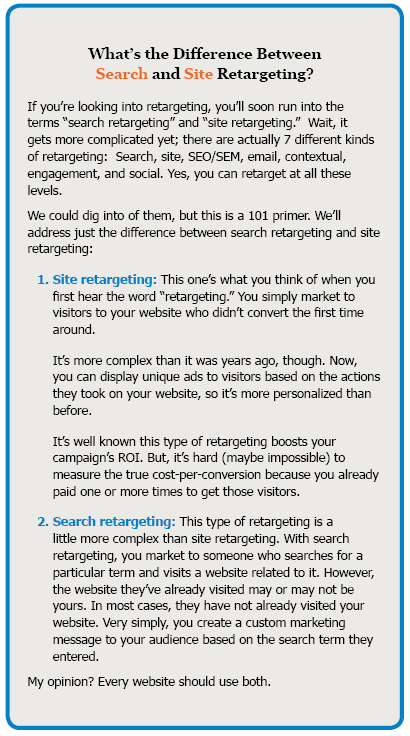 Every business discipline has its own lexicon. (You could make a game out of matching the buzzword to the industry…rightshoring? SOX? Reverse fulfillment?) We certainly have our share in marketing, especially in the digital marketing industry, but some are actually useful. Take “ad retargeting.” It began as a concept, then became a buzzword, and now, thanks to technology, it’s actually a discipline – and a useful one, at that.
Every business discipline has its own lexicon. (You could make a game out of matching the buzzword to the industry…rightshoring? SOX? Reverse fulfillment?) We certainly have our share in marketing, especially in the digital marketing industry, but some are actually useful. Take “ad retargeting.” It began as a concept, then became a buzzword, and now, thanks to technology, it’s actually a discipline – and a useful one, at that.
What is Ad Retargeting?
You’ve surely been on the receiving end of ad retargeting: You did a little research on a product, and suddenly ads for a vendor (and perhaps its competitors) are following you all over the web. Even on websites that are completely unrelated in terms of topic – there’s that ad again, or a similar one, from the same company. That’s ad retargeting in action! The vendor placed a small piece of code on his website; when you visited the original product page, you (unknowingly) downloaded a cookie into your browser. That cookie tells the retargeting ad provider (not the vendor) to serve that ad to you over and over again.
What are the Benefits of Retargeting?
There are plenty of reasons why you, as a marketer, might consider retargeting:
- Get a higher ROI – You have pin-point control over who sees your ads. You can, for example, set a rule to show your ad to only those people who visit one particular page on your website. Retargeting can boost ad response by 400% (CMO.com, 15 Mind-Blowing Stats About Retargeting, Nov. 2013).
- Lower online advertising costs – Retargeting’s cost-per-click is lower than PPC or other types of digital advertising, because it mandates such precise targeting.
- Extend and enhance your branding – If your brand or product is unfamiliar to the prospect, it will take multiple exposures before they remember you. Even if they know who you are, it usually takes multiple exposures to move a purchaser to action. Retargeting gives you that, in a very manageable way that can be automated. A similar effect can be achieved through cross-channel marketing, but it’s won’t be as precise or as measurable, and it will be more (probably much more) expensive.
- Optimize your campaign results rapidly – Retargeting is very agile, and happens quickly. This lets you get in front of many more people, faster. This in turn gives you a lot more data to make decisions from.
- Make your ads highly personal and highly relevant to defined segments – When you follow up your prospect’s behavior with ads that refer to the product or service they researched, you’re speaking to their proven personal interests. The more relevant your ads, the better your outcomes.
- Get more conversions – Website visitors who are retargeted with online ads are 70% more likely to convert on your website (CMO.com, Nov. 2013).
How Retargeting Fits Into Your Strategy
Here are a few good ways you can use retargeting to help you make more sales:
1. Use different ads at each phase of the buying cycle. Every marketer’s funnel is structured a little differently, but overall, they tend to have five distinct components: awareness, interest, evaluation, decision, and purchase. I could write several blog posts on this, so I’ll just use a few examples.
- At the awareness stage, you want the audience to recognize your name and associate you with a category: Big Joe’s has the world’s biggest selection of outdoor gear.
- At the interest stage, you could display ads specific to the product your visitors showed an interest in. Big Joe’s has the best selection of one-man tents.
2. Retargeting works best as part of an overall marketing strategy. You probably use many channels to get your message out. Most visitors to your website are not going to convert the first time around. You could use retargeting to stay in touch with visitors who bounce off your web pages, leave pages with lead capture forms, and who abandon their shopping carts.
3. A simple 4-week strategy.
- Week 1: Target people in the awareness stage using a banner with your logo and value proposition.
- Week 2: Target the same audience as in week 1, but with a little bit more strength. This time, your ad should have your product, company name, headline, logo, and call-to-action.
- Week 3: Give them a product-specific banner but, this time, include a discount to try to get them to move.
- Week 4: Increase the discount, or maybe include a bonus item when they buy.
3 Ad Retargeting Mistakes
Now, as with any marketing technique, you can do things right – or wrong. Watch out for some of these easy-to-make retargeting mistakes:
1. Displaying the wrong ad at the wrong time – Have you ever bought something from a company, and then got followed around by ads asking you to buy the same product? How annoying! Your customer will think you aren’t paying attention to them or that you misunderstand them. Instead of blaring a tone-deaf message, treat them nicely. Offer them accessories or enhancements to the product they just purchased.
2. Linking to the wrong landing pages – If you’re doing a retargeting campaign right, you have many different ads that link to very specific landing pages that in turn correspond to very specific stages in the buying cycle. Make sure they’re all linked correctly to avoid confusion and lost sales.
3. Using ads that are too similar – If you write basically the same old text with a slight change in the image, your ad viewers either get burned out or blind to your ad. There’s no reason for them to pay attention to basically the same old thing. Plus, you’re not going to learn much about what messaging and value proposition your customers like to respond to.
There’s a lot more to retargeting, but we’ve stuck to the basics here in Retargeting 101 for you. Hopefully it saves you a lot of time and mistakes!
Travis Piepho is the founder and CEO of Prospectr Marketing, which offers a full line of sales lead generation solutions, and specializes in email marketing and internet marketing services.

